
Best Acer Swift Go Intel Evo Thin & Light Premium Laptop 14
Table of Contents
Welcome to the epitome of mobility and performance: the Best Acer Swift Go Intel Evo Thin & Light Premium Laptop 14.
Crafted for those who demand excellence in every aspect of their computing experience, this sleek and sophisticated device combines cutting-edge Intel Evo technology with a remarkably thin and lightweight design.
Prepare to be captivated by its premium features, unparalleled portability, and uncompromising performance as we delve into the world of next-level computing with the Acer Swift Go.
Introducing the Acer Swift Go 14, a surprising ultraportable laptop that defies expectations. At first glance, it may resemble Acer’s familiar design language, but don’t be fooled—this iteration packs a punch.
Boasting impressive hardware, including a stunning high-resolution OLED display, Acer has elevated the Swift Go 14 to new heights.
Priced at $1,099.99, it competes fiercely with premium counterparts like the Dell XPS 13 (9315) and Lenovo Yoga 9i Gen 8, offering comparable value and performance. The only drawback? A mediocre keyboard prevents it from reaching its full potential.

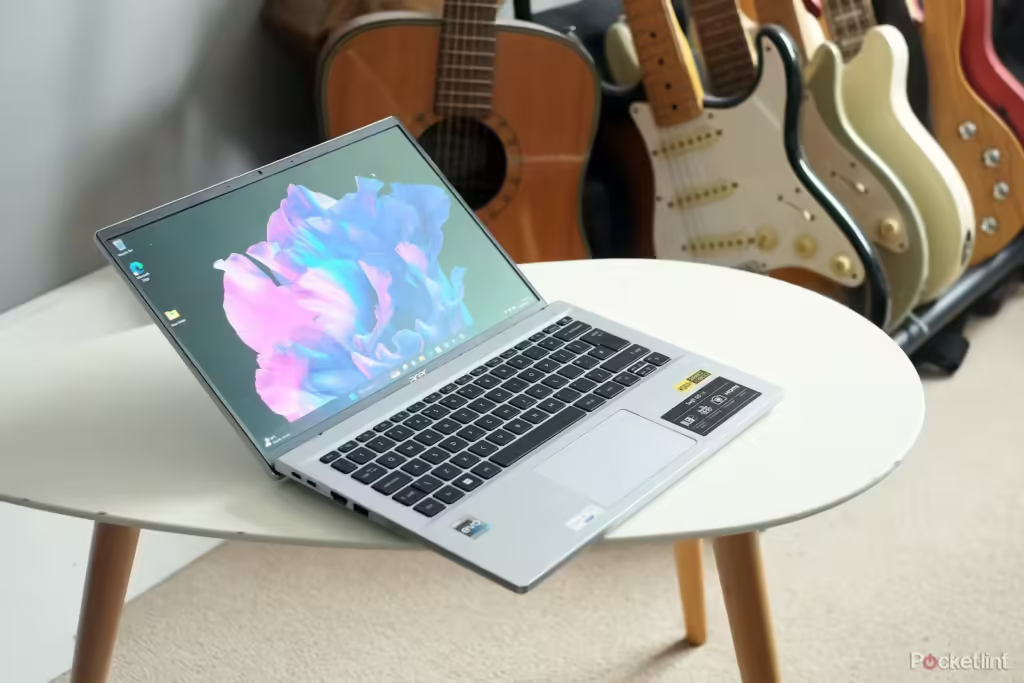
Acer Swift Go 14 Build and Configurations
The Acer Swift Go 14 may seem unassuming at first glance, to the point where one might mistake it for an Acer Aspire.
Acer has certainly maximized the potential of this laptop design, as it closely resembles many of their everyday laptop offerings from recent years.
However, its metal chassis, sturdy hinge, and minimal flex on the keyboard deck attest to its robust build quality.
In this model, Acer has reduced the bezels surrounding the display, allowing for a 16:10 screen aspect ratio rather than the standard 16:9.
Additionally, the surface-mounted vent positioned above the keyboard appears more appropriate on this model compared to others I’ve evaluated, especially considering the potent processor it houses, necessitating effective cooling mechanisms.

Regrettably, due to its design, the Acer Swift Go 14 inherits the keyboard configuration found on less expensive models. While not egregious, the convex key caps may feel unfamiliar, and their slight wobble in the corners compromises the overall feeling of reliability.

Moreover, the key layout incorporates a fingerprint reader within the power button at the top right corner, displacing the Delete key in a manner prone to inadvertent errors.
Similarly, the arrow keys are compacted into a confined space at the bottom right corner, potentially making them more challenging to navigate.

Acer appears to have miscalculated the dimensions and weight of its own device. Discrepancies between reported and measured values are not uncommon due to variations in configurations.
However, in this case, I observed a significant difference. Acer claims a weight of 2.76 pounds and a depth of 0.59 inches, whereas my precise measurements using digital calipers and scales indicate a weight of 2.9 pounds and a depth of 0.73 inches.
Acer’s website showcases five distinct configurations for the Swift Go 14, yet the specific model reviewed here isn’t among them.
However, we managed to locate it on retail platforms such as Amazon and Walmart.
The configurations largely mirror each other, beginning with a 13th Generation Intel Core i5 CPU paired with 8GB of RAM and a 512GB SSD, and ascending to a Core i7 H Series CPU with 16GB of RAM and a 1TB SSD.

It’s worth noting that Acer offers models priced below $1,000 with a 1080p LCD display, while those exceeding $1,000 boast a superior OLED display.
The Acer Swift Go 14 features a 14-inch OLED display with a remarkable resolution of 2,880-by-1,800 pixels (or 1800p), delivering exceptional clarity at its size.
Furthermore, it boasts a refresh rate of 90Hz, ensuring smooth scrolling and visuals.
Although the glossy finish may cause glare, the panel’s high brightness compensates for this, ensuring adequate visibility. Additionally, Acer lists a model priced at $1,199.99 with identical internals but a sharper 3,200-by-1,800 pixel screen, although it’s yet to be spotted elsewhere.
While Acer appears to recycle its older designs, subtle upgrades are undoubtedly being incorporated. Among these upgrades is the inclusion of a fingerprint reader within the power button. Additionally, the device boasts a notably sharp webcam capable of recording at a resolution of 1440p.

While the Acer Swift Go 14 may not achieve the level of thinness Acer initially claimed, its relatively thicker profile offers a commendable array of ports, especially when compared to some of its slim-and-light rivals—ahem, Dell, ahem. On each side, you’ll find a USB 3.2 Gen 1 Type-A (5Gbps) port.
Meanwhile, the left side accommodates two Thunderbolt 4 ports (capable of charging) and an HDMI 2.1 port. On the right side, there’s a 3.5mm headset jack and a microSD slot.
The speakers remain positioned on the bottom outer edges of the laptop frame.

Relying solely on Acer’s product page specifications (a somewhat risky endeavor considering past discrepancies), one might assume that the Acer Swift Go 14 lacks robust wireless capabilities, as it only lists 802.11n wireless, or Wi-Fi 4.
However, the laptop actually features a Killer Wi-Fi 6E AX1675i card, providing significantly improved Wi-Fi 6E and Bluetooth 5.3 connectivity.
Using the Acer Swift Go 14
While I’m not particularly fond of Acer’s convex keyboards, I must admit they aren’t all bad. After a brief adjustment period, I managed to achieve a typing speed of 107 words per minute with 95% accuracy, as assessed using Monkeytype.
Throughout a week of work, I found no significant hindrance to my usual productivity pace. However, the compact arrow keys, shifted Delete key, and absence of dedicated page navigation keys did present some challenges during text editing.

Acer manages to compensate for some of the shortcomings of the keyboard and trackpad with its impressive screen quality.
A 90Hz OLED display is always a delight to behold, and the expanded real estate afforded by its 16:10 aspect ratio allows for ample on-screen content while working on documents.
Even when zooming out on webpages to maximize visibility, the display’s high resolution ensures that small details remain discernible, making even tiny text legible.
Despite the downward-facing speaker positioning, the audio output is reasonably clear with a satisfactory volume, suitable for listening in quiet or small spaces. However, I noticed a lack of low-end frequencies, resulting in certain bass-heavy music sounding noticeably empty.
While adequate for video calls and human voices, these speakers may not cater to the preferences of music enthusiasts.

These days, Acer seems to refrain from overwhelming its laptops with excessive bloatware.
Instead, it includes a handful of popular social media and messaging apps along with a couple of small games.
While Acer does append some web links to certain services, it refrains from cluttering up storage with an excessive amount of pre-installed software.
Testing the Acer Swift Go 14: A Clear Leader in Its Class
Priced around $1,000, the Acer Swift Go 14 sits at the lower end of the spectrum for thin-and-light premium laptops—not quite budget-friendly, yet not as slender as some competitors. Given its configuration and price point, it faces formidable rivals.
The Dell XPS 13 (9315) stands out, albeit at a higher cost to match the Swift Go 14’s storage and memory, and it operates on a less powerful 12th Gen Core i5 U Series processor.
A similar scenario unfolds with the Lenovo Yoga 9i Gen 8, which offers competitiveness but at a higher price point and with a lower-power CPU.
Acer also faces competition from HP. The HP Pavilion Plus 14 offers a similar configuration, albeit with silicon a generation behind, and even shares a similar design.
On the other hand, the Acer Swift Edge presents a thinner and lighter alternative with a larger and sharper OLED display. Despite its higher list price, the Swift Edge often sees discounts, bringing it down to $1,000.
Productivity Tests
We evaluate the real-world productivity capabilities of each laptop by employing UL’s PCMark 10, which simulates office and content creation workflows.
This allows us to gauge overall performance for office-centric tasks like word processing, spreadsheeting, web browsing, and videoconferencing.
Additionally, we conduct PCMark 10’s Full System Drive test to analyze the load time and throughput of each laptop’s storage.
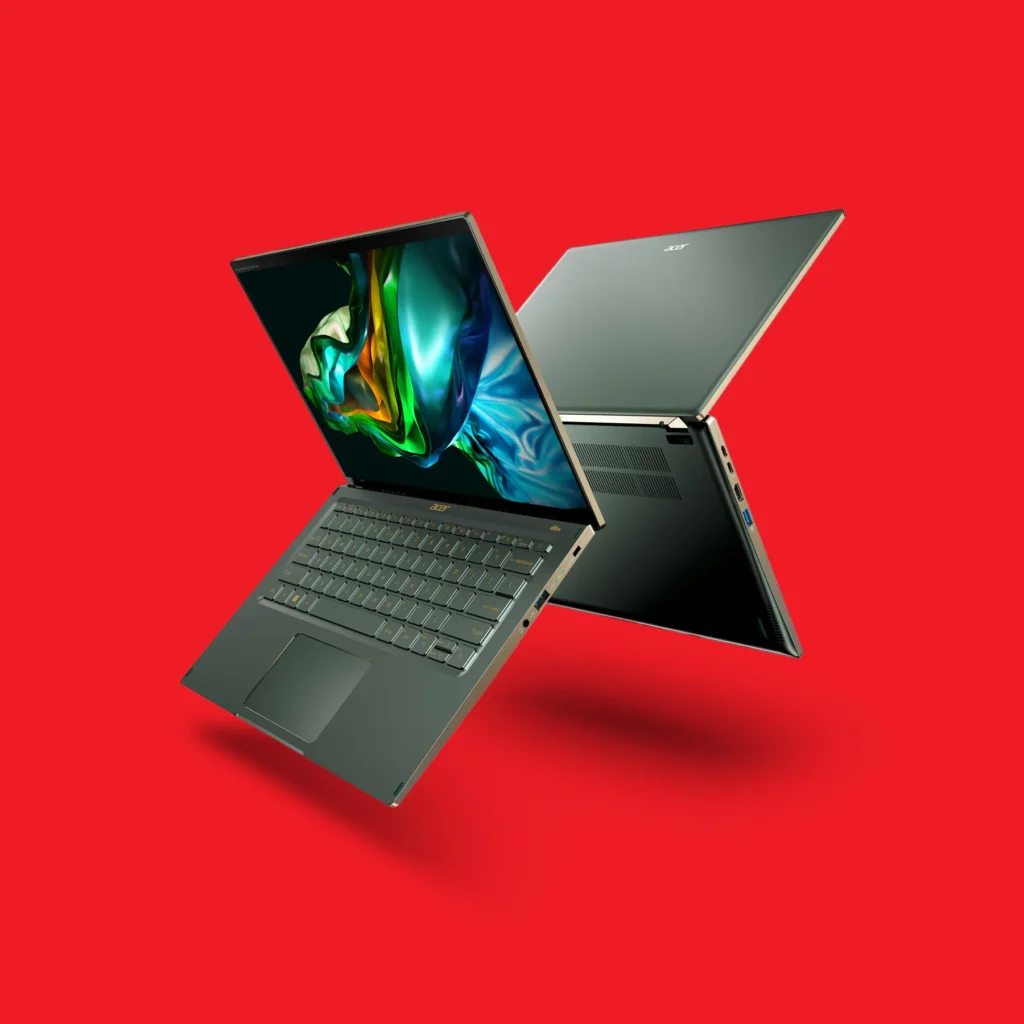
Next, we delve into assessing the system’s CPU performance using benchmarks optimized to leverage the multitude of cores and threads available in each system.
This enables us to evaluate a PC’s capability for handling processor-intensive workloads.
Maxon’s Cinebench R23 employs the company’s Cinema 4D engine to render a complex scene, while Geekbench 5.4 Pro by Primate Labs simulates a range of popular applications, spanning from PDF rendering and speech recognition to machine learning tasks.
Finally, we utilize the open-source video transcoder HandBrake 1.4 to convert a 12-minute video clip from 4K to 1080p resolution, with lower times indicating superior performance.
Regrettably, we were unable to obtain a result in PugetBench due to a recurring error observed in the test, which has been common among many new 13th Gen Intel chips.
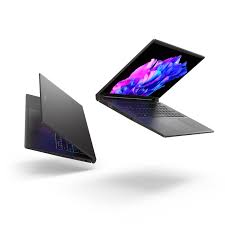
The Acer Swift Go 14 not only met but significantly exceeded expectations—a feat largely attributed to its high-performance CPU and generous memory.
Additionally, the storage employed in this laptop demonstrated remarkable capability. Surprisingly, despite the esteemed lineage of Dell’s XPS laptops, the XPS 13 exhibited the weakest performance across all metrics.
The Acer Swift Go 14 consistently achieved the highest scores in nearly all of these tests, with only one instance where it was closely matched.
This remarkable performance can be attributed to the higher-power H Series CPU featured in this model, a notable advantage over its competitors. Additionally, the Swift Go’s effective cooling mechanism, facilitated by its well-designed frame, likely contributed to its stellar CPU performance.
Graphics Tests
To assess graphical performance, we employ two DirectX 12 gaming simulations on Windows PCs using UL’s 3DMark Night Raid for low-intensity testing and Time Spy for high-intensity testing.
Additionally, we utilize GFXBench 5, a cross-platform GPU benchmark that assesses both low-level routines such as texturing and high-level game-like image rendering.
This benchmark includes the 1440p Aztec Ruins and 1080p Car Chase tests, which are rendered offscreen to accommodate various display resolutions.
These tests stress graphics and compute shaders using the OpenGL programming interface and hardware tessellation, with higher frames per second (fps) indicating superior performance.
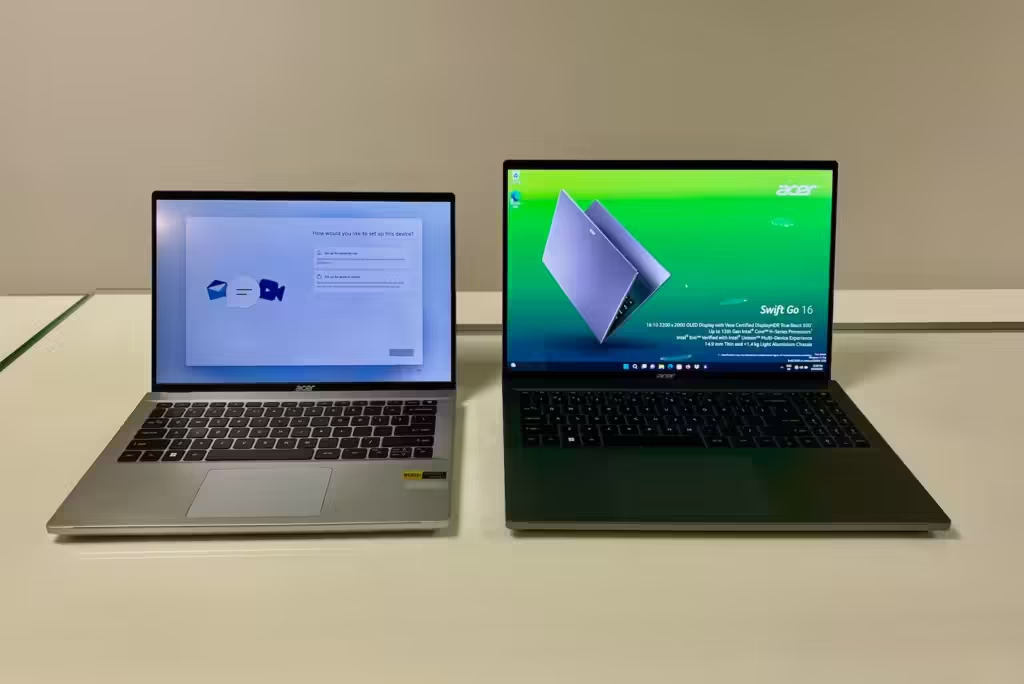
In our graphics testing, the Acer Swift Go 14 delivered another impressive performance.
The integrated Iris Xe Graphics on the Core i7-13700H showcased notable improvements, surging far ahead of the HP Pavilion Plus 14’s Core i7-12700H and outclassing the XPS 13’s results.
The Lenovo Yoga 9i Gen 8 performed commendably, keeping pace with similar graphics hardware on Intel’s Raptor Lake architecture.
However, only the Acer Swift Edge posed a challenge, demonstrating the resilience of AMD’s Radeon integrated graphics. Nonetheless, the competition remained close.
Battery and Display Tests
In our efforts to compare battery life across laptops, we conduct a battery rundown test by playing a locally stored 720p video file (the open-source Blender movie Tears of Steel) with the laptop’s display brightness set to 50% and audio volume at 100%.
Prior to the test, we ensure that the battery is fully charged, with Wi-Fi and keyboard backlighting turned off.
To conduct our display tests, we utilize a Datacolor SpyderX Elite monitor calibration sensor along with its Windows software.
This allows us to measure various aspects of a laptop screen’s performance, including color saturation, represented by the percentage of the sRGB, Adobe RGB, and DCI-P3 color gamuts the display can accurately reproduce.
Additionally, we measure the screen’s brightness levels at 50% and 100% brightness in nits (candelas per square meter).
Despite its impressive performance and budget-friendly price point, the Acer Swift Go 14 doesn’t compromise on display quality.
Its 14-inch OLED panel is exceptional, boasting a high peak brightness of 489.7 nits in standard dynamic range (SDR), with measurements reaching as high as 616 nits for HDR highlights.
Additionally, the screen offers outstanding color accuracy, covering 100% of the sRGB and DCI-P3 color spaces, along with 98% coverage of Adobe RGB—the most comprehensive coverage among all five laptops tested.
Furthermore, the display demonstrates remarkable accuracy, with an average Delta E reading of just 0.59 and a maximum of 1.22. However, it’s worth noting that at 100% brightness, colors may appear overly bright.
While the Acer Swift Go 14 excelled in display quality compared to its competitors, it lagged behind in battery life.
It fell short of reaching nine hours in our battery test, while the other laptops in the comparison managed nine hours or more.
Notably, the Yoga 9i Gen 8 achieved an impressive 14 hours and 5 minutes.
However, Acer’s performance isn’t dismal, considering that the Swift Go 14’s brightness at 50% surpasses that of all laptops except the Dell XPS 13. During the test, Acer’s brightness was nearly twice that of the Yoga 9i Gen 8.
Reducing the Swift Go 14’s brightness could likely extend its battery life noticeably, as OLED displays tend to consume more power than IPS models—a fact illustrated by the Dell XPS 13’s battery performance.
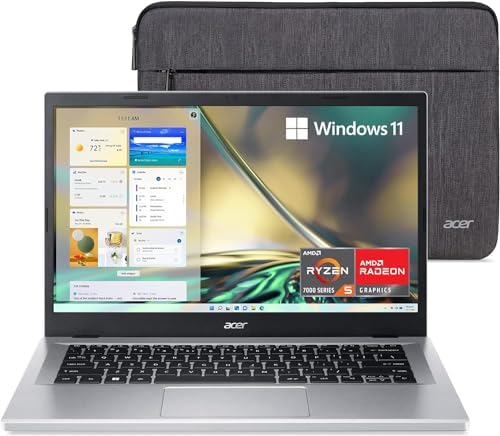
Verdict: A Surprising Value in Everyday Laptops
The Acer Swift Go 14 proves to be a pleasant surprise. With its impressive performance, vibrant display, and satisfactory battery life, it sets a high standard for a device in its price range.
Despite the “Go” in its name suggesting a lower cost, or its competition with thinner and lighter laptops, it strikes a commendable balance between capabilities and hardware, establishing itself as an outstanding value proposition.
ACER SWIFT GO 14 SPECS
| Laptop Class | Ultraportable |
| Processor | Intel Core i7-13700H |
| RAM (as Tested) | 16 GB |
PROS
- Exceptional price-to-performance.
- Brilliant display.
- Decent I/O for a thin-and-light.
CONS
- Unlovable keyboard
- A little thick
price : $524.40

